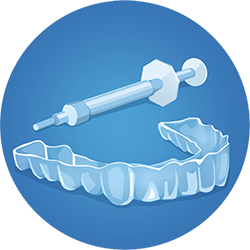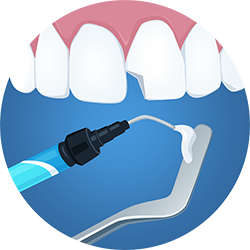
Home whitening
Modern Teeth Whitening: Myths and Reality
The internet abounds with all sorts of information about modern procedures that can help you improve the colour of your teeth. Most of the available articles are pseudo-scientific populist literature, which contains little true scientific evidence and a lot of subjective opinions misleading the readers about the benefits and dangers of teeth whitening. Läänemere hambakliinik offers its patients the most modern and safe methods of treatment, so we have asked Doctor Mihhail Bõtšinski, one of the leading specialists of the clinic, to comment on teeth whitening procedures and associated risks.
These days, teeth whitening is a very popular subject of discussion among the patients of Läänemere hambakliinik. Modern aesthetic needs are increasing, medicine is developing rapidly and, therefore, today we can offer our patients more than ever before. There are three basic and at the same time the most effective types of photochemical teeth whitening:
- In-office whitening
- Home whitening using custom bleaching trays
- Whitening using over-the-counter products (strips, universal bleaching trays, whitening toothpastes , etc.)
Today, the gold standard of modern teeth whitening is home whitening using custom bleaching trays. The forefather of this method is the orthodontist Dr. Bill Klusmier who started using it in the late 1960s. The idea is that a bleaching tray is custom made for each patient and is filled with the whitening gel. The tray with the gel is placed on the teeth, so that the active ingredient of the gel (carbamide peroxide) can penetrate the surface of the teeth. Carbamide peroxide decomposes into free radicals (HO-, HOO-, HOO-, OO–), which begin to attack organic pigmented molecules in the spaces between the inorganic salts in tooth enamel (Dahl and Pallesen, 2003, Joiner, 2006, Minoux and Serfaty 2008), resulting in a whiter colour of the teeth. This process, however, is not always equally effective, as there are many qualitative and quantitative abnormalities of the enamel and other structures of the teeth, which is why the whitening process should be supervised by your dentist, while strictly following the recommendations provided by your doctor. Modern gels contain not only active components but also inactive ones, such as glycerol, propylene glycol, firming agents, surfactants, preservatives and flavourings. The role of the inactive ingredients is simple: they improve the quality of the product, help the active ingredient have a uniform effect on the tooth surface and accelerate the decomposition of harmful end products of breakdown of the active substance. More recently, amorphous calcium phosphate (ACP) has been added to some gels to reduce sensitivity after the bleaching procedures (Berger et al., 2012).
Home whitening has many benefits: control of the situation by the patient, reduced number of visits to the dentist, a high level of safety and a possibility to repeat the procedure in a few years without new investment in whitening trays. It should be noted that the bleaching process can be accompanied by some small concerns, which are generally associated with an increased sensitivity of the necks of the teeth and minor irritation of the gingival margin. Research by Smidt et al., 2011; Sun et al., 2011, Candenaro et al., 2010 shows that the qualitative and morphological changes in the tissues of the teeth, particularly the surface layer of the enamel, are minor or completely absent when using 10-16% concentration of hydrogen peroxide. The same is confirmed by electron microscopy studies conducted by Haywood et al., 1990; Ernst et al., 1996.
Care and Safety Information for Patients Who Want to Whiten Their Teeth:
Key points of safe and modern whitening:
- Use custom trays which will be made based on the shape of your teeth and ordered from a laboratory.
- Try to avoid over-the-counter products, as their safety could be dubious.
- Strictly follow the recommendations of your dentist regarding the whitening regime.
- If you have fillings or crowns in the aesthetic area, you may have to replace them after bleaching. If you are planning to undergo dental restoration of the anterior area, whitening procedures should be performed first, and your teeth can be restored only two weeks later.
Instructions given by doctors of Läänemere hambakliinik to patients who have decided to whiten their teeth:
- Before starting the whitening procedure, it is recommended to undergo a thorough ultrasonic mechanical cleaning and the delicate Air Flow procedure
- For a full whitening cycle of 2-3 weeks you will need 8 tubes of 10% or 16% gel. The gel can be purchased at Läänemere hambakliinik
- Before using the trays, make sure there is no residual dried gel left inside after the previous use. Prepare your teeth for bleaching: floss your teeth and then brush them for 2 minutes
- Evenly spread a small amount of the gel on the outer surface of the tray
- Place the tray so that it accurately covers the entire surface of your teeth. Perform the procedure in front of the mirror to make sure that the tray sits on your teeth snugly and the gel inside has distributed evenly over the outer surfaces of your teeth
- If a small amount of gel comes in contact with the surface of the gums acted, we recommend that you remove it from the surface to avoid irritation
- If you use a 10% gel, keep the trays in your mouth for 6 to 8 hours. If the gel is 16%, the time is reduced to 2 to 4 hours. Repeat the procedure daily for 2 to 3 weeks
- If you feel pain, it is recommended to remove the trays. Sometimes your teeth can become sensitive to cold at an early stage of the whitening cycle. Sensitivity vanishes with time
- After using the trays, rinse your mouth with water thoroughly and wash the trays with a jet of water
- The canines, the cervical area of the teeth and the lower front teeth may require additional bleaching for 2 to 5 days, so that the colour of the teeth becomes more uniform.
- Should you need help or advice regarding teeth whitening, please contact the specialists of Läänemere hambakliinik
- Treatments (General dentistry)
- Implantation
- Teeth extraction
- Microscope-assisted root canal treatment
- Paediatric dentistry
- Frenectomy of the tongue and lips
- Orthodontics
- Laser dentistry
- Periodontitis treatment
- Prosthodontics
- General anaesthesia
- First aid
- Professional cleaning
- Veneers
- Composite fillings
- LED whitening
- Home whitening
- Treatments (General dentistry)
- Implantation
- Teeth extraction
- Microscope-assisted root canal treatment
- Paediatric dentistry
- Frenectomy of the tongue and lips
- Orthodontics
- Laser dentistry
- Periodontitis treatment
- Prosthodontics
- General anaesthesia
- First aid
- Professional cleaning
- Veneers
- Composite fillings
- LED whitening
- Home whitening




